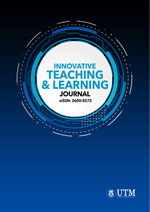Augmented Reality in Read Aloud: An English Language Interactive Engagement
DOI:
https://doi.org/10.11113/itlj.v7.134Keywords:
Augmented Reality, Read-aloud, Motivation, Engagement, Vocabulary enhancement, ComprehensionAbstract
Currently, Augmented Reality (AR) technology is emerging as a popular means to encourage children to enjoy reading books. AR technology, which creates a virtual element from a real physical environment, increases a sense of connectivity between the real and the virtual world. The Read-Aloud project aimed to spark interest in reading English language storybooks among primary school children by innovating the chosen storybook with embedded AR technology. The book, 'Nyatoh the Friendly Tree,' was selected in support of United Nations Sustainable Development Goal No. 15 on the Sustainability of Life on Land, particularly focusing on issues related to trees and sustainable forests. Primary research through a simple questionnaire was distributed to the students and analysed by the researchers using a statistical percentage table. Oral feedback and interactions were observed and recorded by the researchers. A total of 160 students, with 82 aged 12 and 78 aged 10, from a government primary school in the urban city experienced AR in the read-aloud session. The book was initially read to the students, followed by language activities and hands-on AR experiences using smartphones and physical books. All activities were conducted in smaller groups of five. The AR features 3D models of the main character and side characters, including animals from the rainforest. Comprehension questions in the form of a quiz were generated, and to expand vocabulary, audio explanations of words in animation were created. Feedback was gathered at the end of the session in two categories: (a) interest, engagement, and interaction with the story, and (b) comprehension of the language and story. Students reported positive experiences with AR in both categories and generally found the activity fun, interesting, and enjoyable and were motivated to read. While scores in the comprehension area were lower, they still indicated a positive impact of AR on vocabulary comprehension, contributing to the overall understanding of the story. Interaction with animation also plays a role in supporting the sense-making of non-verbal representation. This project demonstrated that AR holds tremendous appeal in generating interest in reading when it incorporates a modification of physical reality with virtual elements. Exploring the potential of AR in storybooks and read-aloud sessions is valuable, especially considering the benefits of reading on learners' development. The research was still in its early stages, with additional variables to be considered. Longitudinal studies could be conducted for clearer validity and reduction of the novelty effect. This includes identifying individual learning styles in software design, providing training for both teachers and students, and developing appropriate learning activities for AR applications.

















